Mud volcano
A mud volcano or mud dome is a landform created by the eruption of mud or slurries, water and gases.[1][2][3] Several geological processes may cause the formation of mud volcanoes. Mud volcanoes are not true igneous volcanoes as they do not produce lava and are not necessarily driven by magmatic activity. Mud volcanoes may range in size from merely 1 or 2 meters high and 1 or 2 meters wide, to 700 meters high and 10 kilometers wide.[4] Smaller mud exudations are sometimes referred to as mud-pots.
The mud produced by mud volcanoes is mostly formed as hot water, which has been heated deep below the Earth's surface, begins to mix and blend with subterranean mineral deposits, thus creating the mud slurry exudate. This material is then forced upwards through a geological fault or fissure due to local subterranean pressure imbalances. Mud volcanoes are associated with
About 86% of the gas released from these structures is methane, with much less carbon dioxide and nitrogen emitted. Ejected materials are most often a slurry of fine solids suspended in water that may contain a mixture of salts, acids and various hydrocarbons.[citation needed]
Possible mud volcanoes have been identified on Mars.[5]
Details

A mud volcano may be the result of a
Approximately 1,100 mud volcanoes have been identified on land and in shallow water. It has been estimated that well over 10,000 may exist on continental slopes and abyssal plains.
Features[citation needed]
- Gryphon: steep-sided cone shorter than 3 meters that extrudes mud
- Mud cone: high cone shorter than 10 meters that extrudes mud and rock fragments
- Scoria cone: cone formed by heating of mud deposits during fires
- Salse: water-dominated pools with gas seeps
- Spring: water-dominated outlets smaller than 0.5 metres
- Mud shield
Emissions

Most liquid and solid material is released during eruptions, but seeps occur during dormant periods.
The mud is rich in halite (rock salt).[citation needed]
First-order estimates of mud volcano emissions have been made (1 Tg = 1 million metric tonnes).
- 2002: L. I. Dimitrov estimated that 10.2–12.6 Tg/yr of methane is released from onshore and shallow offshore mud volcanoes.
- 2002: Etiope and Klusman estimated at least 1–2 and as much as 10–20 Tg/yr of methane may be emitted from onshore mud volcanoes.
- 2003: Etiope, in an estimate based on 120 mud volcanoes: "The emission results to be conservatively between 5 and 9 Tg/yr, that is 3–6% of the natural methane sources officially considered in the atmospheric methane budget. The total geologic source, including MVs (this work), seepage from seafloor (Kvenvolden et al., 2001), microseepage in hydrocarbon-prone areas and geothermal sources (Etiope and Klusman, 2002), would amount to 35–45 Tg/yr."[6]
- 2003: analysis by Milkov et al. suggests that the global gas flux may be as high as 33 Tg/yr (15.9 Tg/yr during quiescent periods plus 17.1 Tg/yr during eruptions). Six teragrams per year of greenhouse gases are from onshore and shallow offshore mud volcanoes. Deep-water sources may emit 27 Tg/yr. Total may be 9% of fossil CH4 missing in the modern atmospheric CH4 budget, and 12% in the preindustrial budget.[7]
- 2003: Alexei Milkov estimated approximately 30.5 Tg/yr of gases (mainly methane and CO2) may escape from mud volcanoes to the atmosphere and the ocean.[8]
- 2003: Achim J. Kopf estimated 1.97×1011 to 1.23×1014 m³ of methane is released by all mud volcanoes per year, of which 4.66×107 to 3.28×1011 m³ is from surface volcanoes.[9] That converts to 141–88,000 Tg/yr from all mud volcanoes, of which 0.033–235 Tg is from surface volcanoes.
Locations
Europe
Dozens of mud volcanoes are located on the Taman Peninsula of Russia and the Kerch Peninsula of Crimea, Ukraine along with the south-western portion of Bulgaria near Rupite. In Italy, they are located in Emilia-Romagna (Salse di Nirano and Salse di Regnano), in the northern front of the Apennines as well as the southern part (Bolle della Malvizza), and in Sicily. On 24 August 2013, a mud volcano appeared in the center of the via Coccia di Morto roundabout in Fiumicino near Rome.[10][11]
Mud volcanoes are located in the Berca Mud Volcanoes near Berca in Buzău County, Romania, close to the Carpathian Mountains.[12] They were declared a natural monument in 1924.
Asia
Central Asia, The Caucasus, and The Caspian Sea
Many mud volcanoes exist on the shores of the
Georgia
There are mud volcanoes in Georgia, such as the one at Akhtala.[13]
Turkmenistan
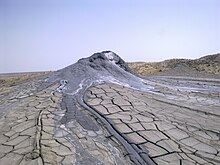
Turkmenistan is home to numerous mud volcanoes, mainly in the western part of the country including Cheleken Peninsula, which borders the Caspian Sea.[14]
Iran and Pakistan (Makran Mountain Range)
Azerbaijan
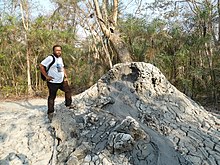
Azerbaijan and its Caspian coastline are home to nearly 400 mud volcanoes, more than half the total throughout the continents.[16] Most mud volcanoes in Azerbaijan are active; some are protected by the Azerbaijan Ministry of Ecology and Natural Resources, and the admission of people, for security reasons, is prohibited.[17] In 2001, one mud volcano 15 kilometres (9 mi) from Baku made world headlines when it started ejecting flames 15 metres (49 ft) high.[18]
In Azerbaijan, eruptions are driven from a deep mud reservoir which is connected to the surface even during dormant periods, when seeping water shows a deep origin. Seeps have temperatures that are generally above ambient ground temperature by 2 °C (3.6 °F) – 3 °C (5.4 °F).[19]
On 4 July 2021, a mud volcano eruption on Dashli Island in the Caspian Sea, near an oil platform off the coast of Azerbaijan, caused a massive explosion and fireball, which was seen across the region, including from the capital Baku, which is 74 kilometres (46 mi) to the north. The flames towered 500 metres (1,640 ft) into the air.[20][21][22] There were no reports of injuries or damage to any oil platforms.[23] The last previous volcanic eruption on the island was recorded in 1945 and the preceding one in 1920.[24]
India
Extensive mud volcanism occurs on the Andaman
Indonesia
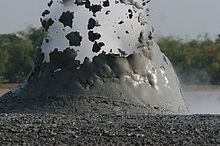
Mud volcanism is a common phenomenon in Indonesia with dozens of structures present onshore and offshore.[26][27]
The Indonesian Lusi mud eruption is a hybrid mud volcano, driven by pressure from steam and gas from a nearby (igneous) volcanic system, and from natural gas. Geochemical, petrography and geophysical results reveal that it is a sediment-hosted[clarification needed] hydrothermal system connected at depth with the neighboring Arjuno-Welirang volcanic complex.[28][29][30][31][32]
Drilling or an
In the Suwoh depression in Lampung, dozens of mud cones and mud pots varying in temperature are found.[citation needed]
In Grobogan, Bledug Kuwu mud volcano erupts at regular intervals,[39] about every 2 or 3 minutes.
Iran

There are many mud volcanoes in
Mariana Forearc
There are 10 active mud volcanoes in the
Pakistan

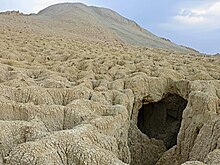
In
Philippines
In the Turtle Islands, in the province of Tawi-Tawi, the southwestern edge of the Philippines bordering Malaysia, presence of mud volcanoes are evident on three of the islands – Lihiman, Great Bakkungan and Boan Islands. The northeastern part of Lihiman Island is distinguished for having a more violent kind of mud extrusions mixed with large pieces of rocks, creating a 20-m (66-ft) wide crater on that hilly part of the island.[42] Such extrusions are reported to be accompanied by mild earthquakes and evidence of extruded materials can be found high in the surrounding trees. Submarine mud extrusions off the island have been observed by local residents.[43]
Other Asian locations
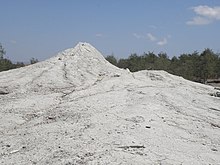
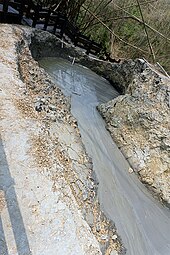
- There are a number of mud volcanoes in Xinjiang.
- There are mud volcanoes at the Minbu Township, Magway Region, Myanmar (Burma).
- There are two active mud volcanoes in southern Taiwan and several inactive ones. The Wushan Mud Volcanoes are in the Kaohsiung City. There are active mud volcanoes in Wandan township of Pingtung County.
- There are mud volcanoes on the island of Pulau Tiga, off the western coast of the Malaysian state of Sabahon Borneo.
- The Meritam Volcanic Mud, locally called the 'lumpur bebuak', located about 35 kilometres (22 mi) from Limbang, Sarawak, Malaysia is a tourist attraction.[44]
- A drilling accident offshore of Brunei on Borneo in 1979 caused a mud volcano which took 20 relief wells and nearly 30 years to halt.
- Active mud volcanoes occur in Viqueque District) erupted between 1856 and 1879.[45]
North America

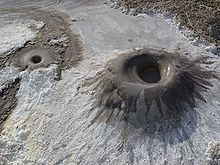
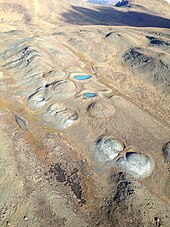
Mud volcanoes of the North American continent include:
- A field of small (<2 metres (6.6 ft) high) fault-controlled, cold mud volcanoes is on California's Mendocino Coast, near Glenblair and Fort Bragg, California. The fine-grained clay is occasionally harvested by local potters.[46]
- Klawasi mud volcanoes in the Copper River basin by the Wrangell Mountains, Alaska. Emissions are mostly CO2 and nitrogen; the volcanoes are associated with magmaticprocesses.
- An unnamed mud volcano 30 metres (98 ft) high and with a top about 100 metres (328 ft) wide, 24 kilometres (15 mi) off Redondo Beach, California, and 800 metres (2,620 ft) under the surface of the Pacific Ocean.
- A field of small (<3 metres (9.8 ft)) mud volcanoes in the Salton Sea geothermal area near the town of Niland, California.[47] Emissions are mostly CO2. One, known as the Niland Geyser, continues to move erratically.[48]
- Smooth Ridge mud volcano in 1,000 metres (3,280 ft) of water near Monterey Canyon, California.
- Kaglulik mud volcano, 43 metres (141 ft) under the surface of the Beaufort Sea, near the northern boundary of Alaska and Canada. Petroleum deposits are believed to exist in the area.
- Maquinna mud volcano, located 16–18 kilometres (9.9–11.2 mi) west of Vancouver Island, British Columbia, Canada.
Yellowstone's "Mud Volcano"
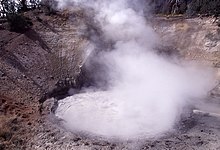
The name of
However, there are mud volcanoes and mud geysers elsewhere in Yellowstone.[49] One, the "Vertically Gifted Cyclic Mud Pot" sometimes acts as a geyser, throwing mud up to 30 feet high.
The mud volcano feature in Yellowstone was previously a mound until a thermal explosion in the 1800s ripped it apart.[50][page needed]
Caribbean

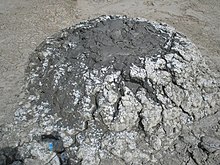
There are many mud volcanoes in
- the Princes Town, Trinidad and Tobago
- the Moruga Bouffe mud volcano near Moruga
- the Digity mud volcano in Barrackpore
- the Piparo mud volcano
- the Chatham mud volcano underwater in the Columbus Channel; this mud volcano periodically produces a short-lived island.
- the Erin Bouffe mud volcano near Los Iros beach
- L'eau Michel mud volcano in Bunsee Trace, Penal
A number of large mud volcanoes have been identified on the Barbados accretionary complex, offshore Barbados.[51]
South America
Venezuela

The eastern part of Venezuela contains several mud volcanoes (or mud domes), all of them having an origin related to oil deposits. The mud of 6 kilometres (3.7 mi) from Maturín, contains water, biogenic gas, hydrocarbons and an important quantity of salt. Cattle from the savanna often gather around to lick the dried mud for its salt content.[citation needed]
Colombia
Volcan El Totumo,[52] which marks the division between Bolívar and Atlantico in Colombia. This volcano is approximately 50 feet (15 m) high and can accommodate 10 to 15 people in its crater; many tourists and locals visit this volcano due to the alleged medicinal benefits of the mud; it is next to a cienaga, or lake. This volcano is under legal dispute between the Bolívar and Atlántico Departamentos because of its tourist value.[citation needed]
Africa
This section needs expansion. You can help by adding to it. (March 2023) |
Australasia
New Zealand
As well as the Runaruna Mud Volcano the size of the splatter cones associated with some of New Zealands many geothermal mud pools or mudpots might qualify, depending upon definition.
Possible mud volcanoes on Mars
-
Wide view of field of mud volcanoes, as seen by HiRISE under HiWish program
-
Close view of mud volcanoes, as seen by HiRISE under HiWish program
-
Close view of mud volcanoes and boulders, as seen by HiRISE under HiWish program
-
Wide view of mud volcanoes, as seen by HiRISE under HiWish program
-
Close view of mud volcanoes, as seen by HiRISE
-
Close view of mud volcanoes, as seen by HiRISE Low area around the volcanoes contains transverse aeolian ridges (TAR's). Only part of picture is in color because HiRISE only takes a color strip in middle of image.
See also
- Asphalt volcano
- Black smoker
- Cold seep
- Hydrothermal vent
- Ice volcano
- Lahar – mud flow
- Methane hydrate
- Sand volcano
- Seamount
- Volcano – igneous volcano
References
- hdl:10852/61234.
- S2CID 21707159.
- .
- .
- ^ "Mars domes may be 'mud volcanoes'". BBC. March 26, 2009. Retrieved 2009-03-27.
- ProQuest 618713361.
- .
- ^ Milkov, Alexei V.; Sassen, Roger (May 2003). Global Distribution and Significance of Mud Volcanoes. AAPG Annual Convention.
- S2CID 195334765.
- ^ "Mini volcano pops up in Rome". Euronews. 28 August 2013.
- ^ Costantini, Valeria (27 August 2013). "Il mini- vulcano con eruzioni fino a tre metri" [The mini-volcano with eruptions of up to three metres]. Corriere della Sera Roma (in Italian).
- ^ "Vulcanii Noroioși – Consiliul Județean Buzău" (in Romanian). Retrieved 2021-05-27.
- ^ Koiava, Kakhaber (October 2016). "The Structure and Geochemistry of the Kila-Kupra Mud Volcano (Georgia)". Vakhtang Bacho Glonti: 2 – via Research Gate.
- – via Research Gate.
- ^ "Mud Volcanoes of Balochistan". 2007-03-02. Archived from the original on 2012-09-15. Retrieved 2009-08-13.
- ^ "MUD VOLCANOES OF AZERBAIJAN". www.atlasobscura.com. Retrieved 29 August 2014.
- ^ "Azerbaijan kicks off project to research mud volcanoes scientifically". Azernews.Az. 2022-07-18. Retrieved 2022-07-19.
- ^ "Azeri mud volcano flares". BBC News. October 29, 2001. Retrieved May 13, 2010.
- S2CID 128779712.
- ^ "Azerbaijan Mud Volcano Erupts in Fiery Display". Smithsonian Magazine. 2021-07-07. Retrieved 2021-07-07.
- ^ "Press conference on incident in the Caspian Sea-VIDEO". Apa.az. Retrieved 2021-07-05.
- ^ "Azerbaijan says "mud volcano" caused Caspian Sea explosion". The Guardian. 2021-07-05. Retrieved 2021-07-05.
- ^ "Mud volcano causes large explosion in the Caspian Sea". BNO News. 4 July 2021.
- ^ "Mud volcanoes explained as huge explosion rocks the oil-rich Caspian Sea". Newsweek. 2021-07-05. Retrieved 2021-07-05.
- .
- .
- ^ .
- hdl:10852/61230.
- .
- S2CID 135102629.
- .
- S2CID 133631006.
- .
- .
- .
- .
- .
- ^ Normile, Dennis (24 February 2011). "Indonesia's Infamous Mud Volcano Could Outlive All of Us". Science. AAAS.
- ^ Nugroho, Puthut Dwi Putranto (15 July 2017). "Bledug Kuwu, Fenomena Letupan Lumpur Unik di Jawa Tengah". kompas.com (in Indonesian). Retrieved 11 November 2022.
- ^ doi:10.14379/iodp.pr.366.2017.)
{{cite book}}: CS1 maint: numeric names: authors list (link - ISSN 0091-7613.
- ^ "Geo-physical Features of Philippine Turtle Island". Ocean Ambassadors Track a Turtle. Retrieved on 2010-10-05.
- ^ "Lihiman Island". Ocean Ambassadors Track a Turtle. Retrieved on 2010-10-05.
- ^ Sheblee, Zulazhar (11 October 2017). "'Volcanoes' pull in the crowd". The Star.
- ^ Sammlungen des Geologischen Reichsmuseums in Leiden, Arthur Wichmann: Gesteine von Timor und einiger angrenzenden Inseln. Leiden, E. J. Brill, 1882–1887 1, Bände 10–11, S. 165
- ^ "Discover northern california". Independent Travel Tours. Archived from the original on 10 October 2008. Retrieved 25 February 2010.
- ^ Howser, Huell (September 7, 2009). "Desert Adventures – California's Gold Special (142)". California's Gold. Chapman University Huell Howser Archive. Archived from the original on June 24, 2013.
- ^ Geggel, Laura (2 November 2018). "A Gurgling Mud Pool Is Creeping Across Southern California Like a Geologic Poltergeist". Live Science.
- ^ "Mud volcano". USGS Photo glossary of volcano terms. Archived from the original on April 4, 2005. Retrieved April 20, 2005.
- ISBN 978-1-57098-021-3.
- .
- ^ "Student Travel Information & Discounts - Events: Volcán de Lodo el Totumo (Mud Volcano) (Volcan de Lodo el Totumo, Colombia)". Archived from the original on 2007-10-07. Retrieved 2007-02-23.
External links
- Origin of mud volcanoes
- Cold water mud volcanoes created by artesian pressure in Minnesota's Nemadji River basin
- Bulletin Of Mud Volcanology Azerbaijan Academy Of Sciences (in English)
- Gaia's Breath—Methane and the Future of Natural Gas Archived 2009-02-12 at the Wayback Machine – USGS, June 2003
- Azeri mud volcano flares – October 29, 2001, BBC report
- Redondo Beach mud volcano with methane hydrate deposits
- Hydrocarbons Associated with Fluid Venting Process in Monterey Bay, California
- Hydrothermal Activity and Carbon-Dioxide Discharge at Shrub and Upper Klawasi Mud Volcanoes, Wrangell Mountains, Alaska – U.S. Geological Survey Water-Resources Investigations Report 00-4207
- Mud Volcano Eruption at Baratang, Middle Andamans
- Article on mud volcanoes from Azerbaijan International
- Mud volcano floods Java, August 2006
- Mud volcano work suspended, 25 Feb 2007, Al Jazeera English
- Possible mud volcano on Mars (BBC News)
- Of Mud Pots and the End of the San Andreas Fault (Seismo Blog)
- Mud Volcanoes at West Nile Delta Video by GEOMAR I Helmholtz-Centre for Ocean Research Kiel
- El Totumo volcano near Cartagena, Colombia on YouTube
- World's Only Moving Mud Puddle on YouTubeshowing the progress over time of the Niland Geyser







